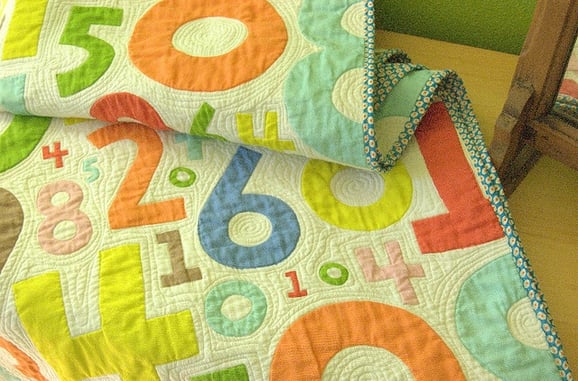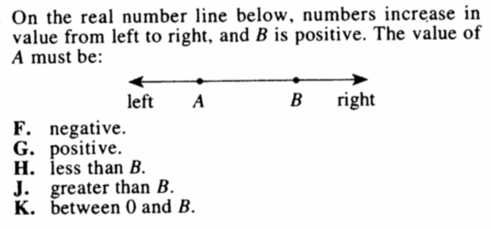
"Let $x$ and $y$ be integers such that ..."
"If $y$ is a positive integer, what is ... ?"
If you've taken the ACT or an ACT practice test, these types of math questions might look familiar to you. You've likely come across several questions on the ACT that mention the word "integer." And if you don't know what this term means, these problems will be difficult to solve.
Questions involving integers are common on ACT Math, so it's important to have a solid grasp of them as you prepare for the test. What are integers and how do they fit into the larger ACT Math picture?
This article will be your guide to basic integers for the ACT, going over what they are, how they change, and how you'll see them used on the test. For the more advanced integer concepts, including absolute values, exponents, roots, and more, refer to our advanced guide to ACT integers.
What Is an Integer?
An integer is a whole number, or any number that is not expressed with a decimal or fraction. Integers include all positive whole numbers, all negative whole numbers, and zero.
Here are some examples of integers:
-32; -2; 0; 17; 2,035
And here are some examples of numbers that are not integers:
$π$, $2/3$, 0.478
 Think of an integer as an object that cannot be divided into pieces. For example, you can't have half an egg in a basket.
Think of an integer as an object that cannot be divided into pieces. For example, you can't have half an egg in a basket.
Positive and Negative Integers

A number line is used to demonstrate how numbers relate to each other and to zero. All numbers to the right of zero are positive numbers, and all numbers to the left of zero are negative numbers.
Positive numbers get larger the farther they are from zero:

Here, we can see that 154 is larger than 12 because 154 is farther along the number line in a positive direction (to the right).
By contrast, negative numbers get smaller the farther they are from zero:

As you can see here, -154 is smaller than -12 because -154 is farther along the number line in a negative direction (to the left).
Another rule you should know is that a positive number will always be larger than a negative number. So, for example, 1 is larger than -10,109.
Below is a sample ACT Math question that tests your knowledge of integers and number lines:

Because we don't have a reference for 0, we cannot say for sure whether $A$ is positive or negative, which eliminates answer choices F, G, and K.
What we do know, however, is that any number to the left of another number will be smaller, meaning the correct answer must be choice H ($A$ is less than $B$).
 The very opposite of a number line.
The very opposite of a number line.
Typical Integer Questions on the ACT Math Section
Most ACT Math integer questions are a combination of a word problem and an equation problem. These questions will usually present you with an equation and then instruct you to use "integers" in place of a variable.
In order to solve these problems, you must know that "integer" means "whole number" (and that integers also include negative numbers and zero).
Here's an example of a fairly straightforward integer question you might see on ACT Math:
For 2 consecutive integers, the result of adding the smaller integer and triple the large integer is 79. What are the 2 integers?
A. 18, 19
B. 19, 20
C. 20, 21
D. 26, 27
E. 39, 40
Sometimes, though, you'll have to answer more abstract questions about how integers relate to one another when you add, subtract, multiply, or divide them. You don't need to find a numerical answer for these types of questions; rather, you must identify whether certain equations will be even or odd and positive or negative.
Here's an example:
If $a$ is an odd integer and $b$ is an even integer, which of the following is an odd integer?
A. $3b$
B. $a+3$
C. $2(a+b)$
D. $a+2b$
E. $2a+b$
For this question, you can either guess and check how integers change in relation to one another by plugging in your own numbers and then solving, or memorize the rules for how integers interact. How you approach these types of math questions is completely up to you and depends on how you learn and/or like to solve math problems.
For example, in the charts below, you'll see this rule:
$\Positive \number * \Positive \number = \Positive \number$
If you forget this rule (or simply don't want to have to learn it in the first place), you can always try it out yourself by simply remembering that $2*3=6$.
Since you can always figure out these results by using your own numbers, we're categorizing the following integer rules as "good to know" (but not "necessary to know"):
| Integer Rule (Multiplying Positives and Negatives) | Example |
| Positive * Positive = Positive | $2*3=6$ |
| Negative * Negative = Positive | $-2*-3=6$ |
| Positive * Negative = Negative | $-2*3=-6$ |
Another way to think of these rules is like this: "When multiplying numbers, the result is always positive unless you're multiplying a positive number and a negative number."
In addition to positives and negatives, you should also know the rules for odd and even numbers:
| Integer Rule (Multiplying Odd and Even Numbers) | Example |
| Odd * Odd = Odd | $3*5=15$ |
| Even * Even = Even | $2*4=8$ |
| Odd * Even = Even | $3*4=12$ |
Here's another way to think of these rules: "When multiplying numbers, the result is always even unless you're multiplying an odd number and another odd number."
Finally, here are the rules to know when adding and subtracting odd and even integers:
| Integer Rule (Adding/Subtracting Odd and Even Numbers) | Example |
| Odd +/- Odd = Even | $5+7=12$ |
| Even +/- Even = Even | $10-6=4$ |
| Odd +/- Even = Odd | $5+6=11$ |
Another way to think of this is like this: "When adding or subtracting numbers, the result is always even unless you're adding or subtracting an odd number and an even number."
With these understandings in mind, let's look again at the above ACT Math problem:
If $a$ is an odd integer and $b$ is an even integer, which of the following is an odd integer?
A. $3b$
B. $a+3$
C. $2(a+b)$
D. $a+2b$
E. $2a+b$
Choice A is incorrect because (1) $b$ is an even integer, and (2) we know that an even number * an odd number = an even number (never an odd number).
Choice B is incorrect because (1) $a$ is an odd integer, and (2) we know that an odd number + an odd number = an even number.
Choice C is incorrect because a is an odd integer and $4b$ is an even integer. An even number + an odd number = an odd number. And an odd number * an even number (in this case 2) = an even number.
Choice D is correct. Two $b$s will be even because an even number * an even number = an even number. And the final result will be odd because an odd number ($a$) + an even number ($2b$) = an odd number.
Choice E is incorrect. 2 multiplied by an odd number ($a$) will be an even number because an even number * an odd number = an even number. And an even number + an even number = an even number.
So your final answer is D: $a+2b$.
You could also solve this by double-checking these rules by plugging in your own numbers. If you assigned an odd number to a and an even number to b, you could test out each option in about the same amount of time it would take to go through the rules as we did here.
So for this question, you could have said $a=5$ and $b=6$. Option D would have then looked like this: $5+2(6)=17$
Again, because you can figure out these kinds of questions using real numbers, these rules are classified as "good to know," not "necessary to know."

If you follow the right steps, solving an integer problem is often much easier than it appears.
How to Solve an ACT Math Integer Problem: 3 Essential Steps
In this section, we'll go over the three steps to remember when it comes to solving any ACT Math integer problem.
Step 1: Confirm That the Problem Is an Integer Problem
If you must use integers to solve a problem, the ACT will explicitly use the word "integer" in the question so that you don't waste your time and effort looking for decimal or fraction solutions. For example, questions may say something like the following:
- "If $x$ is a positive integer such that ..."
- "For all negative integers ..."
- "How many integers give the solution to ... ?"
For any problem that doesn't specify that the variables (or the solution) are "integers," your answer or the variables can be in decimals or fractions.
Let's look again at the problem from earlier:
For 2 consecutive integers, the result of adding the smaller integer and triple the large integer is 79. What are the 2 integers?
A. 18, 19
B. 19, 20
C. 20, 21
D. 26, 27
E. 39, 40
Right away, we can tell that this problem has to do with integers based on the way it's phrased and its direct use of the terms "integer" and "integers." Our five answer choices as well are all (positive) integers.
To solve this problem, let's use some basic algebra. We've got two unknown integers that are said to be consecutive (meaning that one integer is exactly 1 more than the other). Let's call the smaller integer $a$ and the larger integer $b$.
To find the values of two variables, we'll need to come up with a system of equations and solve for each variable.
We know that $a$ must be 1 less than $b$, giving us this equation:
$a=b-1$
We're also told that a added to three times $b$ gives us 79. As an equation, this looks like this:
$a+3b=79$
Now, all we have to do is solve our system of equations to find the values of $\bi a$ and $\bi b$:
$a=b-1$
$(b-1)+3b=79$
$4b-1=79$
$4b=80$
$b=20$
If $b=20$, then $a$ must equal 19 (since it's 1 less than $b$). Therefore, the correct answer is B.
If you wanted to, you could double-check your answer by plugging in 19 and 20 into the second equation above to ensure the result comes out to 79 (spoiler: it does!).
Step 2: For Equations That Are Always True, Test Out Many Different Integers
If an ACT Math question asks you to identify whether certain equations or inequalities are true for all integers, the equation must work with 10, as well as with 0 and -5.
A good rule of thumb is to try -1, 0, and 1 with variable questions like these. These numbers often have special properties that can make or break conditions. Let me explain what that means with a practice question:
If $x$ is an integer, which of the following equations MUST be true?
I. $x^3≥{(-x)}^3$
II. ${x^3}/x≥{x^2}/x$
III. $x(x+1)≤-x+x^3$
A. I only
B. II only
C. III only
D. I and III only
E. I, II, and III
For questions like this, we should test out our sample numbers, since it can get confusing to use our rules of integer behaviors with complex problems such as these.
So for option I, let's use our test numbers of -1, 0, and 1.
$(-1)^3=(-1)(-1)(-1)=-1$
$(--1)^3=1^3=(1)(1)(1)=1$
-1 is not greater than +1.
This automatically eliminates option I. And by eliminating option I, we can also eliminate answer choices A, D, and E.
Now, let's look at option II with our same test numbers.
${-1^3}/{-1}={(-1)(-1)(-1)}/{-1}={-1}/{-1}=1$
${-1^2}/{-1}={(-1)(-1)}/{-1}=1/{-1}=-1$
$1>-1$
This means that option II works so far when we use a negative number. So let's try it with our positive number (1):
${1^3}/1={(1)(1)(1)}/1=1/1=1$
${1^2}/1={(1)(1)}/1=1/1=1$
$1=1$
Option II still works. Lastly, let's test to see whether the equation works with 0:
${0^3}/0=0/0=\undefined$
${0^2}/0=0/0=\undefined$
$\undefined=\undefined$
Option II works for all answer choices, so our final answer is B (option II only). Because we know that option I doesn't work, we've eliminated all other answer choices.
But if you want to make absolutely sure that you didn't make a mistake somewhere, you can test out option III as well. Let's plug in our numbers, starting with −1:
$-1(-1+1)=-1(0)=0$
$-(-1)+(-1)^3=1+(-1)(-1)(-1)=1-1=0$
$0=0$
The two are equal, which means that option III works so far. Now let's try it with 1:
$1(1+1)=1(2)=2$
$-1+1^3=-1+(1)(1)(1)=-1+1=0$
2 is not less than 0 (it's greater than 0).
When we used a positive number (1), the equation became incorrect. This means that answer choice C can be eliminated and our choice of B has been confirmed to be the only correct answer.
#3: When Dealing With Long Calculations, Use Integer Rules or Plug In Smaller Numbers
Some ACT Math integer questions might involve long and complicated-looking equations and/or mathematical statements. You'll have two main options when it comes to your approach here:
- Use your knowledge of the integer rules explained above
- Plug in smaller numbers and test them out to see whether the equation holds true
For the following sample question, we'll show you how you can answer it correctly using both of these options:
$a$, $b$, $c$, $d$, $e$, $f$ are odd integers such that $a>b>c>d>e>f$. Which statement(s) must be true?
I. $abcdef$ is odd
II. $a+b+c+d+e+f$ is odd
III. $a(b+c+d+e+f)$ is odd
A. I only
B. II only
C. III only
D. I and III only
E. I, II, and III
Approach 1: Use Integer Rules
Let's first approach this problem using our integer rules to test option I.
We know that each letter represents an odd integer and that the product of an odd number and another odd number is an odd number. Because an odd number * an odd number will always be odd, we know that option I must be true; therefore, we can eliminate answer choices B and C.
Now, let's look at option II. We know that an odd number + an odd number = an even number. We also know that an even number + an even number = an even number.
If we split $a+b+c+d+e+f$ into pairs of numbers, we get the following:
$(a+b)+(c+d)+(e+f)$
We know that each pair of numbers will have an even sum, so we're left with an even number + an even number + an even number, which will give us an even final result. This means that option II is incorrect and we can therefore eliminate answer choice E.
Finally, let's look at option III.
As we saw before, when we have six odd numbers (that is, an even number of odd numbers), the sum will be even. Since our parentheses hold five (an odd number of) odd numbers and an even number + an odd number = an odd number, we can say that that the number in the parentheses will be odd.
We also know that an odd number ($a$) multiplied by an odd number (the sum of $b, c, d, e, f$) equals an odd number. So option III is correct as well.
This means that our final answer is D (I and III only).
Approach 2: Plug In Numbers
The other way you could solve this problem would be to test out these rules with small numbers and extrapolate to find the larger answer. In other words, you'll use small numbers in place of the variables.
For option I, if you didn't know that an odd number * an odd number = an odd number, you could replace $a$ and $b$ with 5 and 3, respectively. $5*3=15$, which means that an odd number * an odd number = an odd number, no matter how many times you multiply it; thus, option I is correct.
For option II, again test it out with smaller numbers. $7+5=12$, and $7+5+3=15$. So you know that adding odd numbers an even number of times gets you an even answer, and adding an odd number of times gets you an odd answer. There are six odd numbers, so the final answer must be even. Option II is incorrect.
Taking what you learned by testing option II, you know that adding odd numbers an even number of times gets you an odd answer. And taking what you learned from testing option I, you know that an odd number * an odd number = an odd number. This means your final answer must be odd, so option III is correct.
The correct answer, then, must be D (I and III only).
 Whoo! There are many ways to solve integer problems and whichever way works for you is perfect.
Whoo! There are many ways to solve integer problems and whichever way works for you is perfect.
Key Takeaways: What to Know About Integers on ACT Math
In order to solve both the basic and advanced ACT integer questions, you must first understand what an integer is. Only then can you build up your integer knowledge to the more advanced concepts.
Simply knowing that an integer is a whole number (and that 0 and negative numbers are also integers) will allow you to solve some of the more basic ACT Math questions that deal with plugging integers into equations and the relationships among given integers.
To learn about more advanced integer concepts tested on the ACT, including absolute values and exponents, check out our advanced guide to ACT integers.
What's Next?
Now that you've learned what integers are, you may want to check out our advanced guide to ACT integers in which we go through absolute values, prime numbers, and exponents, among other concepts. Make sure that you also have a solid understanding of all the ACT math concepts on the test as well as all the ACT math formulas you'll need to know.
Always running out of time on ACT Math? Check out our expert guide on how to buy yourself those extra precious seconds and minutes so you can complete those ACT Math problems before time's up.
Not sure where to begin with your ACT prep? Start by figuring out your target ACT score.
Already have pretty good scores and looking to get a perfect 36? Take a look at our article on how to get a perfect ACT score, written by a real full scorer!
Want to improve your ACT score by 4 points?
Check out our best-in-class online ACT prep program. We guarantee your money back if you don't improve your ACT score by 4 points or more.
Our program is entirely online, and it customizes what you study to your strengths and weaknesses. If you liked this Math lesson, you'll love our program. Along with more detailed lessons, you'll get thousands of practice problems organized by individual skills so you learn most effectively. We'll also give you a step-by-step program to follow so you'll never be confused about what to study next.
Check out our 5-day free trial:
Have friends who also need help with test prep? Share this article!

Courtney scored in the 99th percentile on the SAT in high school and went on to graduate from Stanford University with a degree in Cultural and Social Anthropology. She is passionate about bringing education and the tools to succeed to students from all backgrounds and walks of life, as she believes open education is one of the great societal equalizers. She has years of tutoring experience and writes creative works in her free time.


































 Holly R.
Holly R.